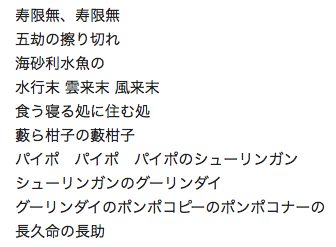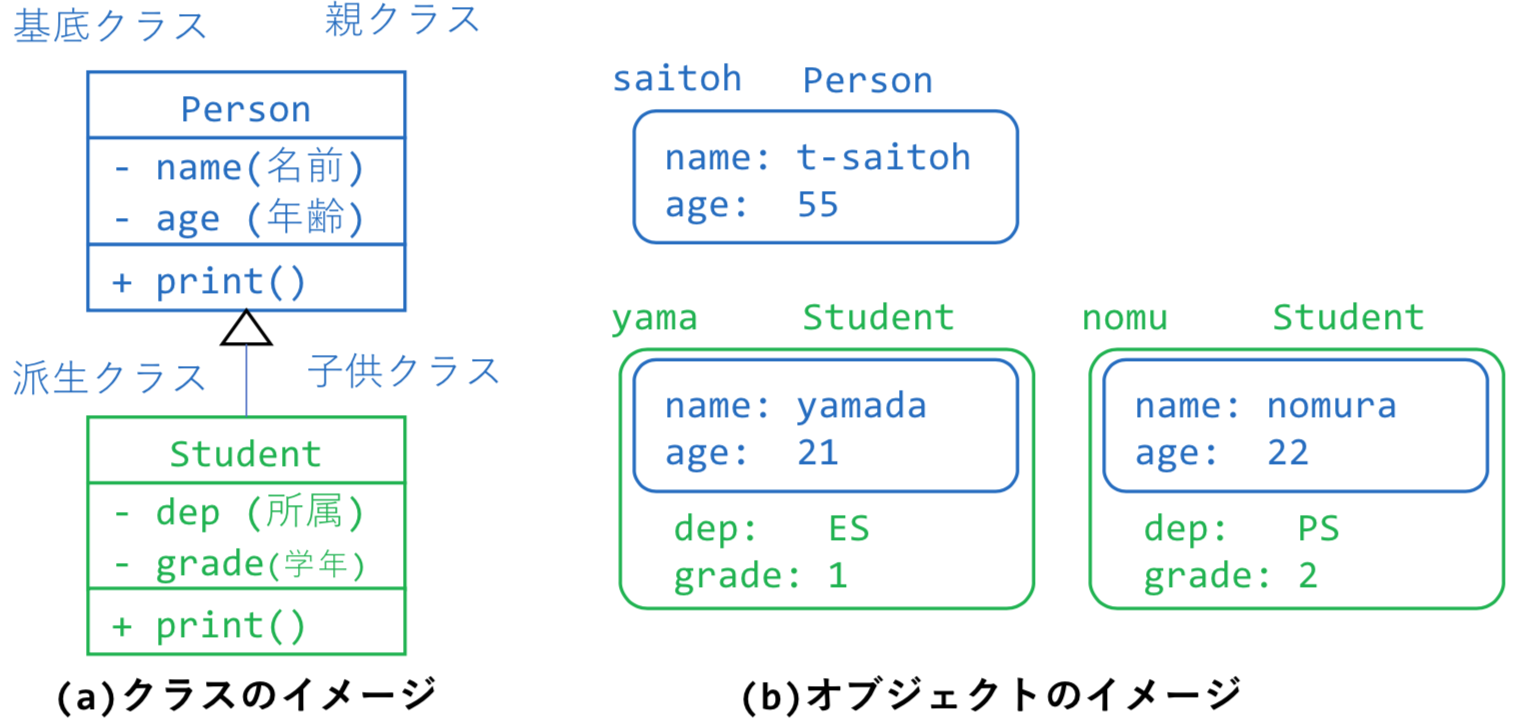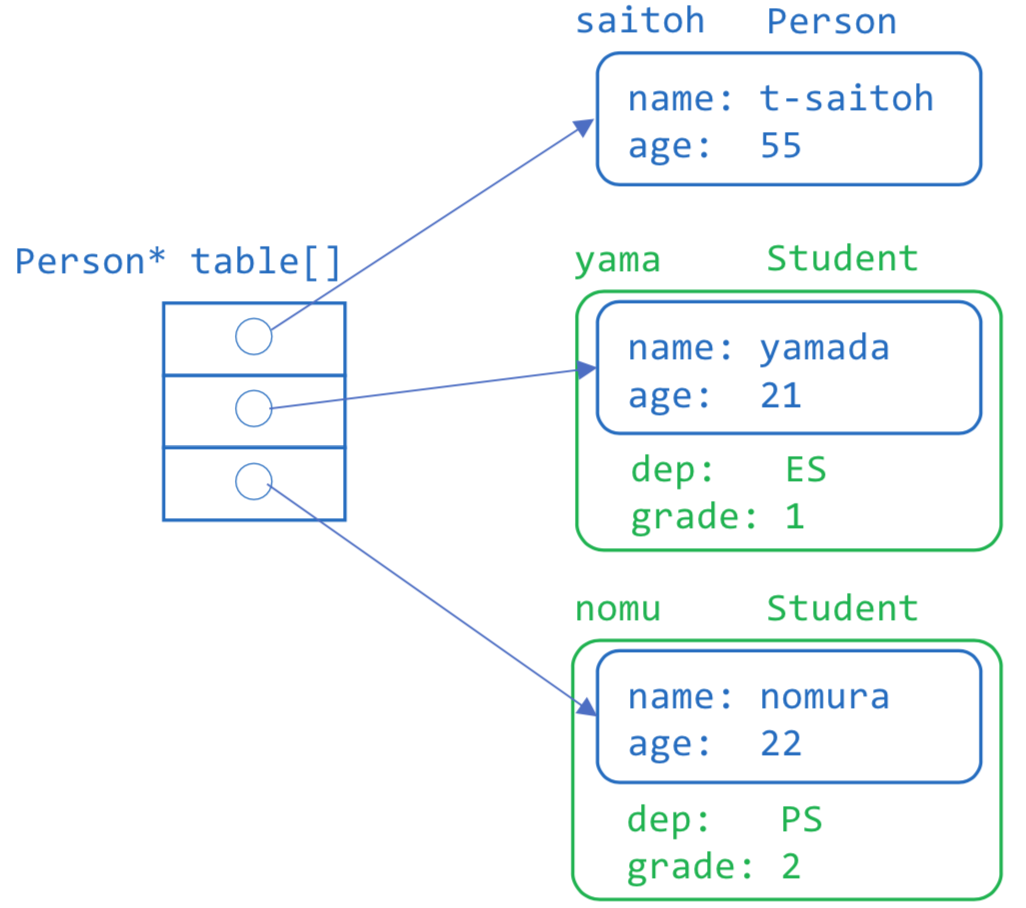効率のよいメモリ使用と動的メモリ/スタック/malloc+free
次にメモリの利用効率の話について解説する。
配列宣言でサイズは定数
C言語では、配列宣言を行う時は、本来ならば、配列サイズに変数を使うことはできない。
最近のC(C99)では、実は下記のようなものは、裏で後述のalloca()を使って動いたりするので普通に書けるけど…。(^_^;
void foo( int size ) {
int array[ size ] ; // エラー
for( int i = 0 ; i < size ; i++ )
array[ i ] = i*i ;
}
int main() {
foo( 3 ) ;
foo( 4 ) ;
return 0 ;
}
メモリ利用の効率
配列サイズには、定数式しか使えないので、1クラスの名前のデータを覚えるなら、以下のような宣言が一般的であろう。
#define MEMBER_SIZE 50 #define NAME_LENGTH 20 char name[ MEMBER_SIZE ][ NAME_LENGTH ] ;
しかしながら、クラスに寿限無とか銀魂の「ビチグソ丸」のような名前の人がいたら、20文字では足りない。(“t-saitoh”くんは配列サイズ9byte、”寿限無”くんは配列220byte といった使い方はできない) また、クラスの人数も、巨大大学の学生全員を覚えたいとい話であれば、 10000人分を用意する必要がある。 ただし、10000人の”寿限無”ありを考慮して、5Mbyte の配列を準備したのに、与えられたデータ量が100件で終わってしまうなら、その際のメモリの利用効率は極めて低い。
このため、最も簡単な方法は、以下のように巨大な文字配列に先頭から名前を入れていき、 文字ポインタ配列に、各名前の先頭の場所を入れる方式であれば、 途中に寿限無がいたとしても、問題はない。
char array[2000] = "ayuka¥0mitsuki¥0t-saitoh¥0tomoko¥0....." ; char *name[ 50 ] = { array+0 , array+6 , array+14 , array+23 , ... } ;
この方式であれば、2000byte + 4byte(32bitポインタ)×50 のメモリがあれば、 無駄なメモリ空間も必要最低限とすることができる。
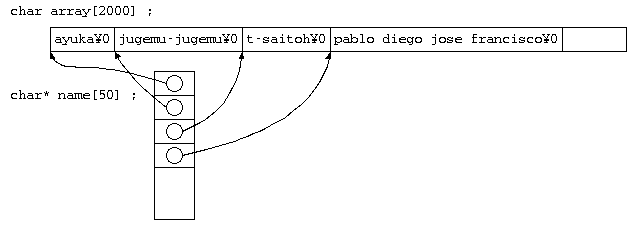
参考:
寿限無(文字数:全角103文字)
さる御方、ビチクソ丸(文字数:全角210文字)
引用Wikipedia(2020年5月リンク切れてる…)
大きな配列を少しづつ貸し出す処理
// 巨大な配列
char str[ 10000 ] ;
// 使用領域の末尾(初期値は巨大配列の先頭)
char* sp = str ;
// 文字列を保存する関数
char* entry( char* s ) {
char* ret = sp ;
strcpy( sp , s ) ;
sp += strlen( s ) + 1 ;
return ret ;
}
int main() {
char* names[ 10 ] ;
names[ 0 ] = entry( "saitoh" ) ;
names[ 1 ] = entry( "jugemu-jugemu-gokono-surikire..." ) ;
return 0 ;
}
// str[] s a i t o h ¥0 j u g e m u - .... ¥0
// ↑ ↑
// names[0] names[1]
このプログラムでは、貸し出す度に、sp のポインタを後ろに移動していく。
スタック
この貸し出す度に、末尾の場所をずらす方式にスタックがある。
int stack[ 100 ] ;
int* sp = stack ;
void push( int x ) {
*sp = x ; // 1行で書くなら
sp++ ; // *sp++ = x ;
}
int pop() {
sp-- ;
return *sp ; // return *(--sp) ;
}
int main() {
push( 1 ) ;
push( 2 ) ;
push( 3 ) ;
printf( "%d¥n" , pop() ) ;
printf( "%d¥n" , pop() ) ;
printf( "%d¥n" , pop() ) ;
return 0 ;
}
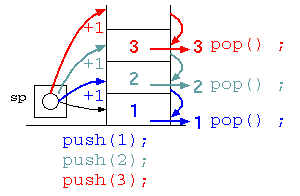
スタックは、最後に保存したデータを最初に取り出せる(Last In First Out)から、LIFO とも呼ばれる。
このデータ管理方法は、最後に呼び出した関数が最初に終了することから、関数の戻り番地の保存や、最後に確保した局所変数が最初に不要となることから、局所変数の管理に利用されている。
alloca() 関数
局所変数と同じスタック上に、一時的にデータを保存する配列を作り、関数が終わると不要になる場合には、alloca() 関数が便利である。alloca の引数には、必要なメモリの byte 数を指定する。100個の整数データを保存するのであれば、int が 32bit の 4byte であれば 400byte を指定する。ただし、int 型は16bitコンピュータなら2byteかもしれないし、64bitコンピュータなら、8byte かもしれないので、sizeof() 演算子を使い、100 * sizeof( int ) と書くべきである。
#include <alloca.h>
void foo( int size ) {
int* p ;
//
p = (int*)alloca( sizeof( int ) * size ) ;
for( int i = 0 ; i < size ; i++ )
p[ i ] = i*i ;
}
int main() {
foo( 3 ) ;
foo( 4 ) ;
return 0 ;
}
alloca() は、指定された byte 数のデータ領域の先頭ポインタを返すが、その領域を 文字を保存するために使うか、int を保存するために使うかは alloca() では解らない。alloca() の返り値は、使う用途に応じて型キャストが必要である。文字を保存するなら、(char*)alloca(…) 、 intを保存するなら (int*)alloca(…) のように使う。
ただし、関数内で alloca で確保したメモリは、その関数が終了すると、その領域は使えなくなる。このため、最後に alloca で確保したメモリが、最初に不要となる…ような使い方でしか使えない。
malloc()とfree()
malloc() は、動的(ヒープ領域)にメモリを確保する命令で、データを保存したい時に malloc() を実行し、不要になった時に free() を実行する。
malloc() では、alloca() と同じように、格納したいデータの byte 数を指定する。また、malloc() は、確保したメモリ領域の先頭を返すが、ヒープメモリが残っていない場合 NULL ポインタを返す。処理が終わってデータ領域をもう使わなくなったら、free() で解放する必要がある。
基本的には、確保したメモリ領域を使い終わった後 free() を実行しないと、再利用できないメモリ領域が残ってしまう。こういう処理を繰り返すと、次第にメモリを食いつぶし、仮想メモリ機能によりハードディスクの読み書きで性能が低下したり、最終的にOSが正しく動けなくなる可能性もある。こういった free() 忘れはメモリーリークと呼ばれ、malloc(),free()に慣れない初心者プログラマーによく見られる。
ヒープメモリは、プロセスの起動と共に確保され、プログラムの終了と同時にOSに返却される。このため、malloc()と処理のあとすぐにプロセスが終了するようなプログラムであれば、free() を忘れても問題はない。授業では、メモリーリークによる重大な問題を理解してもらうため、原則 free() は明記する。
文字列を保存する場合
#include <stdlib.h>
char* names[ 10 ] ;
char buff[ 1000 ] ;
// 名前を10件読み込む
void inputs() {
for( int i = 0 ; i < 10 ; i++ ) {
if ( fgets( buff ,
sizeof( buff ) ,
stdin ) != NULL ) {
names[ i ]
= (char*)malloc( strlen(buff)+1 ) ;
if ( names[ i ] != NULL )
strcpy( names[ i ] , buff ) ;
}
}
}
// 名前を出力する
void prints() {
for( int i = 0 ; i < 10 ; i++ )
printf( "%s" , names[ i ] ) ;
}
int main() {
// 文字列の入力&出力
inputs() ;
prints() ;
// 使い終わったら、free() で解放
for( int i = 0 ; i < 10 ; i++ )
free( names[ i ] ) ;
return 0 ;
}
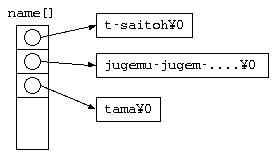
文字列を保存する場合には、上記の names[i] への代入のような malloc() と strcpy() を使うことが多い。
このための専用の関数として、strdup() がある。基本的には、以下のような機能である。char* strdup( char* s ) { char* p ; if ( (p = (char*)malloc( strlen(s)+1 )) != NULL ) strcpy( p , s ) ; return p ; }また、入力した文字列をポインタで保存する場合、以下のようなプログラムを書いてしまいがちであるが、図に示すような状態になることから、別領域にコピーする必要がある。
char buff[ 1000 ] ; char* name[10] ; for( int i = 0 ; i < 10 ; i++ ) { if ( fgets( buff , sizeof(buff) , stdin ) != NULL ) name = buff ; }
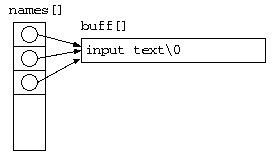
配列に保存する場合
任意サイズの配列を作りたい場合には、malloc() で一括してデータの領域を作成し、その先頭アドレスを用いて配列として扱う。
#include <stdlib.h>
void main() {
int size ;
int* array ;
// 処理するデータ件数を入力
scanf( "%d" , &size ) ;
// 整数配列を作る
if ( (array = (int*)malloc( sizeof(int) * size )) != NULL ) {
int i ;
for( i = 0 ; i < size ; i++ )
array[i] = i*i ; // あんまり意味がないけど
for( i = 0 ; i < size ; i++ )
printf( "%d¥n" , array[i] ) ;
// mallocしたら必ずfree
free( array ) ;
}
}
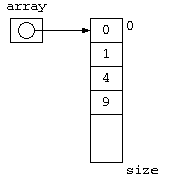
構造体の配列
同じように、任意サイズの構造体の配列を作りたいのであれば、配列サイズに「sizeof( struct Complex ) * データ件数」を指定すればいい。
#include <stdlib.h>
struct Complex {
double re , im ;
} ;
// 指定した場所にComplexを読み込む。
int input_Complex( struct Complex* p ) {
return scanf( "%f %f" ,
&(p->re) , &(p->re) ) == 2 ;
}
// 指定したComplexを出力
void print_Complex( struct Complex* p ) {
printf( "%f+j%f¥n" , p->re , p->im ) ;
}
void main() {
int size ;
struct Complex* array ;
// 処理する件数を入力
scanf( "%d" , &size ) ;
// 配列を確保して、データの入力&出力
if ( (array = (struct Complex*)malloc(
sizeof(struct Complex) * size )) != NULL ) {
int i ;
for( i = 0 ; i < size ; i++ )
if ( !input_Complex( &array[i] ) )
break ;
for( i = 0 ; i < size ; i++ )
print_Complex( &array[i] ) ;
// mallocしたら必ずfree
free( array ) ;
}
}
派生と継承と仮想関数
前回の派生と継承のイメージを改めて記載する。
// 基底クラス
class Person {
private:
char name[ 20 ] ;
int age ;
public:
Person( const char s[] , int x )
: age( x ) {
strcpy( name , s ) ;
}
void print() {
printf( "%s %d\n" , name , age ) ;
}
} ;
// 派生クラス(Student は Person から派生)
class Student : public Person {
private:
char dep[ 20 ] ;
int grade ;
public:
Student( const char s[] , int x ,
const char d[] , int g )
: Person( s , x ) // 基底クラスのコンストラクタ
{ // 追加された処理
strcpy( dep , d ) ;
grade = g ;
}
void print() {
Person::print() ; // 基底クラスPersonで名前と年齢を表示
printf( "- %s %d\n" , dep , grade ) ;
}
} ;
int main() {
Person saitoh( "t-saitoh" , 55 ) ;
Student yama( "yamada" , 21 , "ES" , 1 ) ;
Student nomu( "nomura" , 22 , "PS" , 2 ) ;
saitoh.print() ; // 表示 t-saitoh 55
yama.print() ; // 表示 yamada 21
// - ES 1
nomu.print() ; // 表示 nomura 22
return 0 ; // - PS 2
}
このような処理でのデータ構造は、次のようなイメージで表される。
派生クラスでの問題提起
基底クラスのオブジェクトと、派生クラスのオブジェクトを混在してプログラムを記述したらどうなるであろうか?
上記の例では、Person オブジェクトと、Student オブジェクトがあったが、それをひとまとめで扱いたいこともある。
以下の処理では、Person型の saitoh と、Student 型の yama, nomu を、一つの table[] にまとめている。
int main() {
Person saitoh( "t-saitoh" , 55 ) ;
Student yama( "yamada" , 21 , "ES" , 1 ) ;
Student nomu( "nomura" , 22 , "PS" , 2 ) ;
Person* table[3] = {
&saitoh , &yama , &nomu ,
} ;
for( int i = 0 ; i < 3 ; i++ ) {
table[ i ]->print() ;
}
return 0 ;
}
C++では、Personへのポインタの配列に代入する時、Student型ポインタは、その基底クラスへのポインタとしても扱える。ただし、このように記述すると、table[] には、Person クラスのデータして扱われる。
このため、このプログラムを動かすと、以下のように、名前と年齢だけが3人分表示される。
t-saitoh 55 yamada 21 nomura 22
派生した型に応じた処理
上記のプログラムでは、 Person* table[] に、Person*型,Student*型を混在して保存をした。しかし、Person*として呼び出されると、yama のデータを表示しても、所属・学年は表示されない。上記のプログラムで、所属と名前を表示することはできないのだろうか?
// 混在したPersonを表示 for( int i = 0 ; i < 3 ; i++ ) table[i]->print() ; // Student は、所属と名前を表示して欲しい t-saitoh 55 yamada 21 - ES 1 nomura 22 - PS 2
上記のプログラムでは、Person型では、後でStudent型と区別ができないと困るので、Person型に、Person型(=0)なのか、Student型(=1)なのか区別するための type という要素を追加し、type=1ならば、Student型として扱うようにしてみた。
// 基底クラス
class Person {
private:
int type ; // 型識別情報
char name[ 20 ] ;
int age ;
public:
Person( int tp , const char s[] , int x )
: type( tp ) , age( x ) {
strcpy( name , s ) ;
}
int type_person() { return type ; }
void print() {
printf( "%s %d\n" , name , age ) ;
}
} ;
// 派生クラス(Student は Person から派生)
class Student : public Person {
private:
char dep[ 20 ] ;
int grade ;
public:
Student( int tp , const char s[] , int x ,
const char d[] , int g )
: Person( tp , s , x ) // 基底クラスのコンストラクタ
{ // 追加された処理
strcpy( dep , d ) ;
grade = g ;
}
void print() {
Person::print() ; // 基底クラスPersonで名前と年齢を表示
printf( "- %s %d\n" , dep , grade ) ;
}
} ;
int main() {
// type=0 は Person 型、type=1は Student 型
Person saitoh( 0 , "t-saitoh" , 55 ) ;
Student yama( 1 , "yamada" , 21 , "ES" , 1 ) ;
Student nomu( 1 , "nomura" , 22 , "PS" , 2 ) ;
Person* table[3] = {
&saitoh , &yama , &nomu ,
} ;
for( int i = 0 ; i < 3 ; i++ ) {
switch( table[i]->type_person() ) {
case 0 :
table[i]->print() ;
break ;
case 1 :
// 強制的にStudent*型として print() を呼び出す。
// 最近のC++なら、(static_cast<Student*>(table[i]))->>print() ;
((Student*)table[i])->print() ;
break ;
}
}
return 0 ;
}
しかし、このプログラムでは、プログラマーがこのデータは、Personなので type=0 で初期化とか、Studentなので type=1 で初期化といったことを記述する必要がある。また、型情報(type)に応じて、その型にふさわしい処理を呼び出すための switch 文が必要になる。
もし、派生したクラスの種類がいくつもあるのなら、型情報の代入は注意深く書かないとバグの元になるし、型に応じた分岐は巨大なものになるだろう。実際、オブジェクト指向プログラミングが普及する前の初期の GUI プログラミングでは、巨大な switch 文が問題となっていた。
仮想関数
上記の、型情報の埋め込みと巨大なswitch文の問題の解決策として、C++では仮想関数(Virtual Function)が使える。
型に応じて異なる処理をしたい関数があったら、その関数の前に virtual と書くだけで良い。このような関数を、仮想関数と呼ぶ。
// 基底クラス
class Person {
private:
char name[ 20 ] ;
int age ;
public:
Person( const char s[] , int x )
: age( x ) {
strcpy( name , s ) ;
}
virtual void print() {
printf( "%s %d\n" , name , age ) ;
}
} ;
// 派生クラス(Student は Person から派生)
class Student : public Person {
private:
char dep[ 20 ] ;
int grade ;
public:
Student( const char s[] , int x ,
const char d[] , int g )
: Person( s , x ) // 基底クラスのコンストラクタ
{ // 追加された処理
strcpy( dep , d ) ;
grade = g ;
}
virtual void print() {
Person::print() ; // 基底クラスPersonで名前と年齢を表示
printf( "- %s %d\n" , dep , grade ) ;
}
} ;
int main() {
// type=0 は Person 型、type=1は Student 型
Person saitoh( "t-saitoh" , 55 ) ;
Student yama( "yamada" , 21 , "ES" , 1 ) ;
Student nomu( "nomura" , 22 , "PS" , 2 ) ;
Person* table[3] = {
&saitoh , &yama , &nomu ,
} ;
for( int i = 0 ; i < 3 ; i++ ) {
table[i]->print() ;
}
return 0 ;
}
クラスの中に仮想関数が使われると、C++ では、プログラム上で見えないが、何らかの型情報をオブジェクトの中に保存してくれる。
また、仮想関数が呼び出されると、その型情報を元に、ふさわしい関数を自動的に呼び出してくれる。このため、プログラムも table[i]->print() といった極めて簡単に記述できるようになる。
関数ポインタ
仮想関数の仕組みを実現するためには、関数ポインタが使われる。
以下の例では、返り値=int,引数(int,int)の関数( int(*)(int,int) )へのポインタfpに、最初はaddが代入され、(*fp)(3,4) により、7が求まる。
int add( int a , int b ) { return a + b ; } int mul( int a , int b ) { return a * b ; } int main() { int (*fp)( int , int ) ; fp = add ; printf( "%d\n" , (*fp)( 3 , 4 ) ) ; // 3+4=7 fp = mul ; printf( "%d\n" , (*fp)( 3 , 4 ) ) ; // 3*4=12 int (*ftable[2])( int , int ) = { add , mul , } ; for( int i = 0 ; i < 2 ; i++ ) printf( "%d\n" , (*ftable[i])( 3 , 4 ) ) ; return 0 ; }仮想関数を使うクラスが宣言されると、一般的にそのコンストラクタでは、各クラス毎の仮想関数へのポインタのテーブルが型情報として保存されるのが一般的。仮想関数の呼び出しでは、仮想関数へのポインタを使って処理を呼び出す。このため効率よく仮想関数を動かすことができる。
